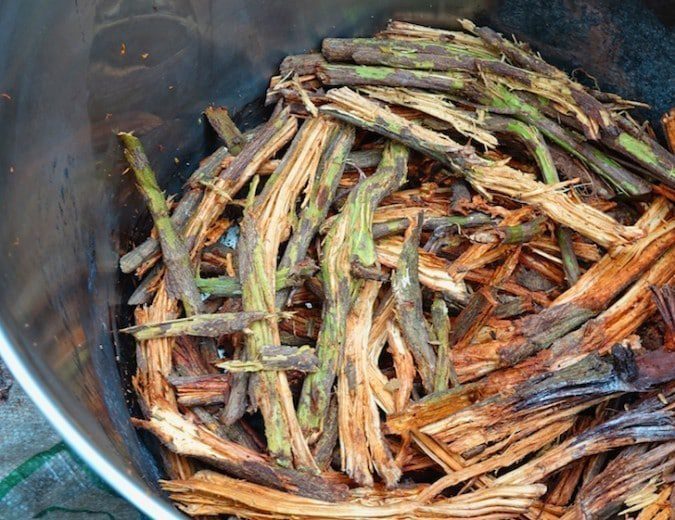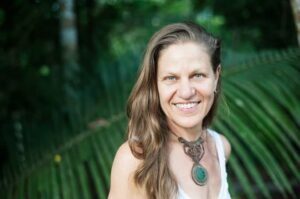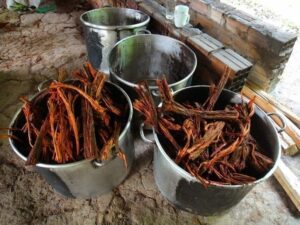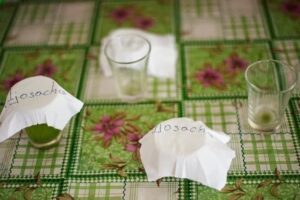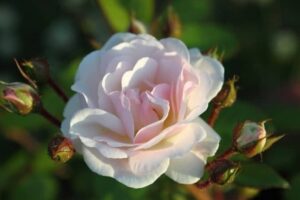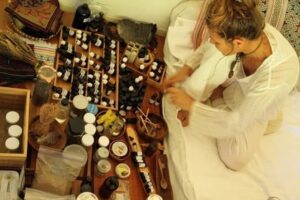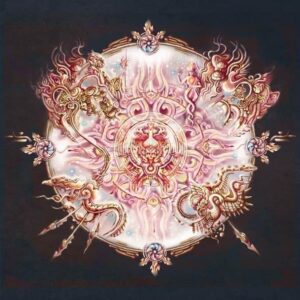Plantswoman and shamanic practitioner Sitaramaya Sita created Visionary Convergence to find common ground and cultivate community and awareness for entheogenic (“generating the divine within”) visionary plants such as ayahuasca, psilocybin mushrooms, iboga, peyote, cannabis, San Pedro cactus, and other psychedelic sacred medicines. Sita has a passion for powerful plants and people, a gift for bringing gifted people together, and has produced a remarkable boutique event that is not to be missed. “When we look at the community of people who are investigating and utilizing plant medicines, the common ground really is emerging,” Sita says.
Sita is focusing on plants (and fungi) — rather than synthetics — at Convergence. I’m very pleased about this, because my husband, ethnobotanist Chris Kilham, and I share this particular passion in a big way. For us, this is a calling. Plants communicate with humans like they do with other living beings and with each other. Plants — especially sacred plants like ayahuasca, cannabis, and peyote — have helped humans grow throughout the ages and continue to help us steward our spiritual evolution.
Reset: We so appreciate that you are focusing on plant spirit!
Sita: Plant spirit as an element is missing from synthetically produced medicines in the modern world, and the spiritual element of healing is one of the main topics of conversation at Convergence. How do want to define medicine in the 21st century? It makes so much sense to be connecting with the spiritual element in plants.
Reset: They have healing properties and things to teach us.
Sita: Pharmaceuticals certainly can help us physically, but the spiritual part of the plants speaks to the spiritual component in us and sets the stage for wholeness — as opposed to disconnection where maybe our bodies feel great but our spirits or our souls do not. When we talk about resonance with the plants as spirit element, to me it is a metaphor for how important the spiritual element is in our own wellbeing.
Reset: We have these beautiful minds, and they do so much for us. But our minds can also create suffering — re-running narratives or patterns of thinking that don’t serve us.
Sita: Our mind is such an incredible, powerful tool. But we tend to let our minds run our lives instead of recognizing that our minds are in service to who we really are. Instead, if we come from a place of gratitude and of spirit and soul and say, “I have this amazing body, I have this incredible, intelligent mind,” well, then we can say, “Let them be of service to the person I truly am,” which to me is my heart and soul. My higher self.
Reset: Tell me about your North American practice.
Sita: I’m a working practitioner and the cornerstone of my practice is stewarding dietas with master plants. The master plants, or “teacher plants” are part of the rich and diverse pharmacopoeia of healing plants and trees that exist everywhere. Dieting with plants is a classic Amazonian tradition, and we’re doing it in North America. I have been studying dietas with master plants for over fifteen years. I also work with intentions and with integration. I also create personalized, hand-formulated pusangas, which is your own unique aromatic potion that no one else on the planet has—and so much more.
Reset: Can you explain to readers what a dieta is?
Sita: A dieta is when you receive a diagnosis or have a problem you want to work on. We ask, “What would be a good plant to diet with?” And this becomes a daily practice of being with the plant, working in the dreamtime, day to day. In an herbalist’s tradition, it might be a plant to help with a physical problem like arthritis or asthma. In our tradition, it may be more of an emotional problem. Let’s say, for instance, that you feel shut down or disconnected and want to open up to spirit or have a closer connection with oneness. Certain plants help with those things.
The diet, or dieta, is opened ceremonially with a chant. You take the plant every day at the same time. You get into a position of repose after taking the plant, and you ask your dreams to instruct you.
Reset: And we also practice an agreed-upon series of restrictions.
Sita: Dieta is really about getting rid of all the distractions and seeing what’s there and what you reach for. And then coming back to our plant every day, which is really like coming back to ourselves, and then asking the plant to help us, and allowing the communication with the plant to guide us. So while I’m stewarding the diet, it is the practice of the dieter to cultivate a relationship with the plant and relationship with themselves and with the medicine within themselves.
Reset: What type of restrictions?
Sita: No sugar, no salt, no spices. No dairy. No red meat. No alcohol, no recreational drugs, no cannabis. No extremely hot or cold foods, no excess sun, no curse words, no foul language. Stay away from situations that aggravate. You’re preparing your own food. And no sex, including masturbation.
Reset: I remember you telling me once to avoid aggressive, violent movies and news while preparing for ceremony. I’ve found that to be so helpful.
Sita: We don’t need violent aggressive news, video games, or anything of that nature when we’re preparing to work with the medicine… Hopefully going without raises the question, do we really need it other times? Is this something actually, inherently of value or is it sensationalism? Or is it actually being promoted to prey on our fears and insecurities? You also have to be mindful about what machine is promoting it and what you’re supporting by paying to see it. I’m pretty conscious about where I put my money.
Reset: Tell me about your work with master plants.
Sita: I think it’s important to recognize the value in all medicinal plants, and a lot of plants don’t get the spotlight. If you think about the cosmology of ayahuasca-using cultures, the ayahuasca has been a tool by which shamans and seers could divine which plant will help a patient heal. Certain plants are used to clear your heart or system or energy — that’s the thinking behind the divination of a plant.
I work with and learn from master plants. I apprenticed in the Shipibo shamanic tradition of the Peruvian Upper Amazon, where I learned about master plants like ajo sacha, ayahuma, and marosa — but the Amazon hasn’t cornered the market on master plants. They’re all around us, including master plants here in North America like white sage, sequoia, and jasmine.
Reset: Did you always feel drawn to plants?
Sita: I grew up in urban inner city working class-poor Philadelphia — concrete, cement, no backyard to speak of — but I had plants in my dreams. One of my earliest memories was when I was about 8. I was going to run away and build a hut in the forest — in the New Jersey Pine Barrens, because that was all I knew.
In my dreams and in my 8-year-old mind, there was nothing that was not doable. I literally felt “held” by the forest. That’s where I would see myself. And the plants supported me and gave me what I needed and I knew I was going to be taken care of in this womb of the forest. I would say, “Give me the trees and the plants and the animals and birds and insects any day!” So there was always this image of being in a forest with wildlife.
Reset: So you are a plant person brought up in a world (mostly?) without plants. Were there any plants around?
Sita: In the backyard there was this one little strip of rose bushes. I always wanted to be digging in the dirt. Dirt and grass were few and far between, but if it was there, I was there, and if there was even a little bit of “wildlife,” I was on it. I remember my mother explaining to me that you have to snip roses when they flower, so I did and they would smell so good and course I loved them so much.
Reset: The spirit of the rose helped me comprehend the concept of plant spirit, and then open to it fully. People don’t have a problem with saying “the spirit of the rose.” It was a bridge for me, and I’ve found it to be a bridge for others, too.
Sita: For a long time I had this combination of connection and aversion with the rose at the same time — because while it is beautiful and smells divine, it also has thorns that can hurt. Then, when I moved onto this beautiful land — just over an acre of natural land in Los Angeles County — there was an overgrown rose garden that I couldn’t get to. I cleared it up, and at that point the rose spirit connection was just full on. And now I harvest the roses for flower baths and also use them to make aromatic tinctures for my hand-formulated, individualized pusangas and fragrant anointments.
Reset: It’s Aphrodite’s flower — so a sacred plant, for sure! She’s love and beauty and creativity.
Sita: If you look at some of the wild roses and the rose hips, even, their leaves are heart-shapes, and with their lush, sensual beauty and intoxicating smell — if they’re true garden roses — there’s no mistaking the connection with love and romance and matters of the heart. When I’m in ceremony, rose is always with me. Rose absolute is one of my main oils.
Reset: Tell me about your spectacular custom scents, the pusanga that you create. Other than smelling divine, what is their purpose?
Sita: A pusanga is an aromatic, fragrant plant potion and an all-natural, hand-formulated, plant-based perfume for self-anointing. The powerful aromatics and energies of plant essences are used to clear, amplify and balance energy, provide protection, fortification and fortitude, enhance dreaming, and inspire creativity and spiritual connection. They also help attract the right people and situations in your life.
Reset: And how do you make them?
Sita: I create pusangas during private sessions. A personalized pusanga starts with a clearing, balancing and aligning of the person’s energy flow. During the session, I channel plant spirits, and call my guides and the person’s to provide insight and guidance. I ask people to come with an intention, a question, or an issue or area in their life that they are seeking clarity or direction with.
All of my preparations are made with only the purest source materials of roots, shoots, leaves, flowers, barks, resins, woods and precious oils. During the private session, we connect spiritually and energetically with plants, oils, extracts and resins that I will use to prepare the pusanga. The session concludes ceremonially with a chant for the person sitting in front of me, which is a blessing of their unique pusanga.
I also do prepared pusangas now, in very small artisan batches — no two alike.
Reset: Tell in your own words what an icaro is.
Sita: An icaro in North American terms is “a prayer for your well-being.” An icaro is an emanation of your plants and your practice that is coming forth to meet the intention and what’s being called forth for healing, clearing, and transformation in the person sitting before you.
Reset: Is it improvisational?
Sita: For me it is all improvisational and different every time because the person and the situation are different every time. When I chant in ceremony, there are phrasings that I use, but I’m following the vision of the chant and the vision of the chant is completely driven by what’s happening to the person who is sitting in front of me and what’s happening in the maloka. So the person who is sitting in front of me is calling forth from the medicine what they need.
You have to be in the flow of the moment. We say, “Give yourself to the chant,” and that’s really a big leap of faith because you don’t know what’s going to come out when you open your mouth. My experience is that all of my plants and my diets are behind me sitting in an amphitheater. I open up and get out of the way, and they come through me in the form of an icaro to meet what is present. And the person sitting in front of me is pulling them through, and the icaro comes out of my neck and back and crown to meet whatever is present.
Helping to cultivate and keep the fire of non-linguistic communication alive is really important. We’re so messaged all the time in the language of words. And we’re so word language-bound that when we can communicate without them, then maybe we can get somewhere.
Reset: Ayahuasca messages and lessons often come to us to in symbols, archetypes, abstractions — like a waking dream.
Sita: It is difficult to linguistically speak about what is often a non-linguistic experience and communication. For me, ayahuasca has facilitated cross-species communications with the plants often in the form of visual visions. Visions can also be sensations, sound vibrations, and smells, and then we are getting into the arena of what science calls synaesthesia — a union or blending of the senses. And when two or more of the senses join, for example, we can hear colors or taste sound.
Ayahuasca can also facilitate the dissolution of our waking consciousness that perceives a time and space construct. When that happens, we can access ourselves in a different way, outside the bounds of time, outside the bounds of language that we use in our waking consciousness. [We] often to try and make sense of the world, and we can communicate with ourselves in a moment that just passed, or a moment to come, or years a moment ago. When we do that, really, we are communicating with our truest self at the soul level.
Quite commonly, the visionary experience emerges in colors, fractals, designs, expansive landscapes, archetypical images — all of which are us and the medicine, us and the universe, us and the download revealing itself, often quite beautifully, sometimes not so beautifully. The most cursory view of visionary art gives us a feel for what we are talking about here. The “language” of the soul is not word bound — it is a beingness that is communicated.
Reset: Tell me about your environmental work and nonprofit in the Amazon rainforest.
Sita: I steward a land conservation project called Fundo Sitaramaya in the Peruvian Amazon where I am protecting an area of old growth trees and helping to maintain the delicate balance of native forest plants, birds, animals and waterways there.
Reset: Was there a catalyst event?
Sita: There was, yes. When an elder campesino (one who lives on the land) was preparing to depart the land, I witnessed the destruction that started to take place by people poaching the old growth cedar and mahogany trees. I quietly acquired the land and built a home for a young local mestizo (mixed) family that now cares for the land and protects its borders.
Reset: And [you’re] planting native medicinals?
Sita: Yes! Over the years, we have planted master plants — primarily ayahuasca, chacruna and chaliponga — to ensure that these beloved plants will thrive for generations to come. And the family that lives there has dependable income and health care and has been able to send their daughter to a good school.
Artist and environmental activist Zoe Helene (@zoehelene) is passionate about promoting and connecting kindred-spirit trailblazers in mutually supportive ways. Through Cosmic Sister (@cosmicsister) advocacy projects, she helps communicate messages of love, liberty, and informed pro-activism. Zoe is a devoted wildlife advocate and Woman of the Psychedelic Renaissance.
For more information on Visionary Convergence, which is sponsored by Reset alongside several other visionary and plant advocacy organizations, visit PlantTeachers.com. With interest in plant medicines at an all-time high, remaining tickets will go quickly!
